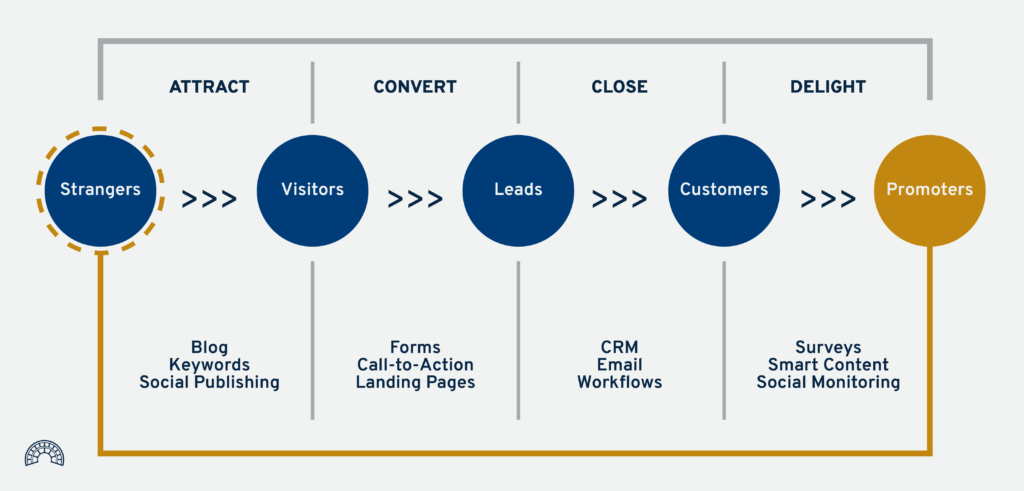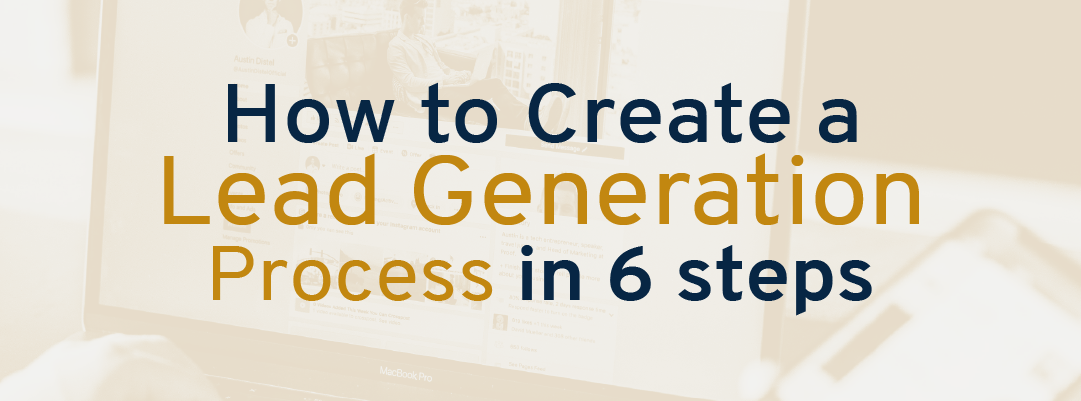A lead generation process can be divided into two major categories: the lead funnel and the lead process itself.
The lead funnel consists of 4 steps: attract, convert, close, and delight. It shows the user’s transformation from a stranger to your brand to its promoter.
On the other hand, the lead generation process has 6 steps: target audience, valuable content, content strategy, lead qualification, nurturing leads, and conversion.
This process shows what your brand should do in order to get organic leads and eventually convert them into customers.
Before getting started, let’s remember that a lead is an individual interested in your business: your products and/or services. They could potentially buy from you, but they aren’t there ‘quite yet’.
On the other hand, lead generation, at first, is the process of attracting potential customers and letting them know about your business’ existence.
Having a lead generation process is important for two main reasons:
- Having a defined and measurable lead generation process will allow you to invest in fewer resources and have better results.
This is especially important if you have a small business or need to save as much money as possible while still generating sales.
- Identify your business’ weaknesses and strengths. This way, you will also know which parts of the process should be improved in order to generate more leads and make more conversions.
Contents
The Lead Funnel
This funnel shows how a stranger can become a promoter of your brand in four steps: attract, convert, close, and delight.

Here is a brief explanation of each one:
- Attract: by organic search (and great keyword use), social media publishing, and even paid media, you can attract strangers to your website.
They know you might have what they are looking for, and strangers become visitors.
- Convert: via forms, calls-to-action between your website and landing pages, you will be able to identify people who become even more interested in you after visiting your website.
Now you have more information about them. This is how visitors become leads.
- Close: now comes the time to directly communicate. Through CRM (Customer Relationship Management), e-mails, phone calls, and other workflows, you will hopefully close the deal and start building an actual relationship with the lead.
Once the purchase takes place, the lead becomes a customer.
- Delight: a lot of businesses have a funnel that ends in the third step. However, we want to go further. After the purchase, ask the client to fill out surveys, create smart content and make some social monitoring.
Always be kind and thoughtful to your customer, and you will turn them into a promoter.
6 Steps for Lead Generation Process
It is now time to explain what a lead generation process can look like while focusing mainly on the brand and the content it produces.
Disclaimer: just like the lead funnel, this process might change depending on your specific customer’s journey, audience, or marketing tactics.
Without further ado, these are the 6 steps of building a lead generation process for your business and/or personal brand:
#1 Define a Target Audience and Research It
The first step is essential to any brand. If you don’t know your target, you won’t know how to sell your services or products.
When the time comes to implement a lead generation process, your audience becomes extremely important once again.
You must know who you are trying to reach if you want the next steps on this list to be successful.
In order to define your target, you can make workshops, conduct market research, etc.
You can check out more ideas on how to find your niche in this article of ours.
Once you define your audience, it’s important you take the time to get to know it. You must understand their wants and needs.
This information will give you insights on how to connect with them and how to improve your products, services, and/or process.
#2 Create Valuable Content
Once you know your target audience, you can start creating valuable content in order to make yourself known in the area.
This content can come in many forms:
The main idea is for you to position yourself as an expert in your industry. When you share your knowledge with the public, you generate trust.
This is the philosophy of one of our favorite books at Latinpresarios: They Ask, You Answer.
“Whoever is willing to answer your question first, in most cases, is the one who will get the first phone call of contact”.
#3 Create and Implement a Content Strategy
According to MarketMuse, a content strategy is “an ongoing process of transforming business objectives and goals into a plan that uses content as a primary means of achieving those goals”.
A content strategy is one of the main pillars of an inbound marketing strategy, which is very important when trying to build a brand and get new clients.
Once you have valuable content ideas, you must create and distribute them across your channels and social media profiles.
This sounds like a lot of work, but if you organize the content and build a calendar, everything will run smoothly.
If you have a personal brand or work in B2B, you might be interested in our LinkedIn content strategy blog.
#4 Qualify Your Leads and Stats
If you have followed the previous steps, sooner or later you will start getting leads.
Keep in mind that inbound strategies take a longer time to generate results.
Once you do, you must analyze and judge your leads.
Not everyone that’s interested in your brand is a good fit for your products and/or services.
Learning how to identify this will save you a lot of time in the future.
Disclaimer: if someone isn’t a good fit it doesn’t necessarily mean they are bad or mean people. A lot of the time, it means that they need something different than what you’re offering them.
On the other hand, you must also check where are the leads coming from. Are they mainly from social media, organic search or referral?
What kind of leads are they?
If you have access to your lead’s demographic data, you will be able to adjust your content strategy in order to make your brand more attractive.
#5 Nurture Your Leads
Now that you know your leads, it’s time to take care of them and transform them into customers.
As we explained earlier in this article, there is a funnel leads to follow and eventually transform into customers and even promoters of your brand.
You should be reaching out and connecting to your leads.
Show them you are the right fit and how you can solve their problems.
Show them you’re an expert in your field.
Give them options and build a relationship.
The relationship is highly important if you want them to eventually:
- Buy from you again.
- Recommend your business to other people (a.k.a. become promoters).
#6 Convert Your Leads into Customers
By this time, you should have an even better idea of which leads are a good fit and which ones aren’t.
This is the moment where the right leads know enough information about you and are ready to make a purchase.
It’s moment to pass the leads to your sales team and let them close the deals.
If you did a great job before this step, which means:
- You created a relationship with the lead.
- You empathized with them.
- You gave them options.
- You made sure they were well informed before deciding to purchase.
Chances are that they will be satisfied and become promoters.
If somewhere in this process you realize they aren’t good potential customers, you can have referral partners.
A referral partner, in this case, is someone whose products and services are similar or can be mistaken for yours.
For example, you have a home-construction medium company. You renovate and build houses. Your referral partner is another company that does drywall installation.
It’s not the same service, but certain customers can get confused from time to time. Or maybe they think they need to fully renovate a room when it’s not that necessary.
Having a referral partner will bring benefits for both parties and makes the lead’s experience much more pleasurable.
Benefits of Implementing a Lead Generation Process
At Latinpresarios, we strongly encourage you to think about your current lead generation process and how can it be improved.
Some of the benefits you will find along the way are:
- A lead generation process will significantly improve the way your brand generates sales.
- It will ‘force’ you to better define your brand, your ideal customer, and what you offer.
- It will motivate you to strengthen certain areas of your company.
- It will allow you to build better budgets.
Remember, the 6 basic steps your lead generation must have are:
- Define a target audience and research it.
- Create valuable content.
- Create and implement a content strategy.
- Qualify your leads and stats.
- Nurture your leads.
- Convert your leads into customers.






